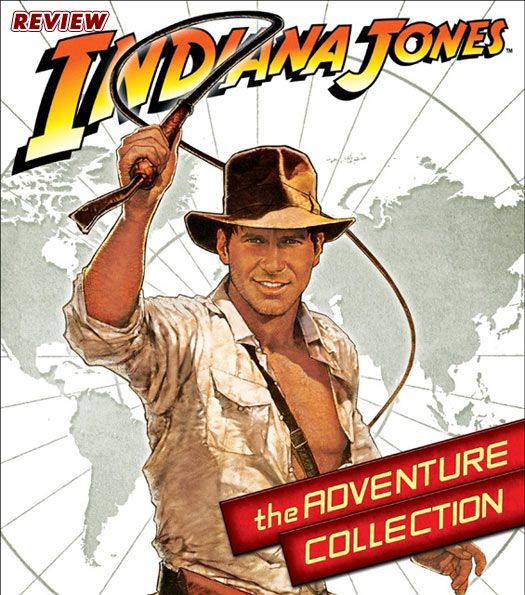At this point, reviewing the films in the Indiana Jones trilogy is a pointless exercise. For many of us, these films are woven into the tapestry of our lives – watched countless times on video and television. Enjoyed again and again with family and friends. They are omnipresent peaks in between the hills and valleys of the pop culture landscape. George Lucas and Steven Spielberg have created a series of timeless films whose legacy expands in one week with the release of Indiana Jones and The Kingdom of the Crystal Skull – nearly 19 years since the intrepid archeologist’s last adventure, Indiana Jones and The Last Crusade.
So, to that end, what is the reason behind re-releasing the first three films on DVD? Especially when they were first released (to much fanfare in 2003)? Clearly it’s a money grab on the part of Paramount, but a welcome one because included are several new bonus features that might be worth your while. Since the Indiana Jones trilogy set such a high water mark in the pop culture consciousness, we’ll be highlighting the DVD extras in this review rather than the films themselves to help you determine if this box set is something you want to add to your DVD collection. The re-released films can be found in stores today, Tuesday, May 13.
Each of the three films contain an “introduction” featuring Lucas and Spielberg speaking about their respective films, but it’s really more of a 20 minute retrospective than an introduction. These are the most revealing and insightful of the collections many extras specifically because they highlight something I’ve assumed for a long time.
George Lucas is an idiot.
Don’t get me wrong. I owe George Lucas a lot. He’s an amazing conceptualist who was able to envision whole galaxies and he has provided me a great deal of entertainment of the years. So I thank him for that.
But as an Executive Producer, he fails – and these featurettes prove it.
Talking about the casting decision to put Harrison Ford under Indy’s famous fedora, Lucas wasn’t for it. Savvy film fans know that the role was originally given to Tom Selleck who was unable to commit to the role due to his involvement with Magnum, P.I. For was Spielberg’s first choice, but Lucas objected siting the success of Star Wars and his concerns that audiences would only be familiar with Ford has Han Solo.
Similarly, for The Last Crusade, Lucas did not want Sean Connery for the role of Indy’s father – concerned that audiences would not accept him in the subordinate sidekick role. Additionally, he was concerned that audiences would only see Connery as 007 – despite the fact that he hadn’t made a James Bond movie (not counting Never Say Never Again) since 1965. Speilberg actually had to convince Lucas that James Bond was the prototype for Indiana Jones in several ways and therefore having Connery play Indiana Jones’s father made sense in a cinematic way.
Most damning, however, is the featurette on The Temple of Doom. Spielberg pretty much comes right out of the gate saying that the movie wasn’t profitable, it wasn’t well-liked by critics, is the most downbeat and least enjoyable of the original three films. Watching again for the first time in a few years, I myself had not noticed how bleak it actually is. Very violent and almost gory. Specifically, the scenes of child abuse in the temple strike a nerve in a way they haven’t before. I guess being a parent now, a switch must have flipped.
But what gets revealed here is Lucas’s insistence that The Temple of Doom go down a dark path. He insisted on it, in fact – siting the success of The Empire Strikes Back. In Lucas’s mind, the second act of a trilogy needs to be downbeat so the hero can rally and come back stronger in the third installment. He actually says this in the featurette.
But there’s a problem with this logic. The Indiana Jones trilogy was not written as one film like Star Wars was. They are episodic like the old Republic adventure serials. The second issue is that – chronologically – The Temple of Doom actually takes place one year before Raiders of The Lost Ark. So shouldn’t the first movie be the downtrodden one.
Most outrageously of all, after Spielberg talks about his distaste for the film, Lucas admits that it is also his least favorite of the three because of it’s dark tone. “I’m more of a humor guy,” he says.
WHAT?! I actually had to pause the DVD and rewind it to make sure I heard him right.
It just goes to show that Lucas doesn’t trust his actors or even his audience to interpret his films correctly. Points for professionalism go to Spielberg, however, who expresses that he was a director hired to execute Lucas’s vision and performed the role he was hired to do.
For those of you hoping for an audio commentary on these movies, you’re out of luck. The “introduction” featurettes are as close as you’re going to get to listening to Spielberg and Lucas wax philosophical on their films.
Other featurettes on Raiders of The Lost Ark include “Indiana Jones: An Appreciation” where cast members from Indiana Jones and The Kingdom of The Crystal Skull talk about the first three movies and their memories of each. It’s a fluff piece that will probably have greater context after The Kingdom of The Crystal Skull comes out on DVD, but, for now, feels highly promotional.
More interesting in the featurette “The Melting Face” where we go behind-the-scenes and talk to the effects supervisor who created the most nightmare-inducing effect of the early 80’s with Toht’s melting face after the Ark of the Covenant is opened. They show you how it’s done from start to finish, providing side-by-side comparisons to the original effect with a recreation developed specifically for release.
The featurettes on The Temple of Doom include “Creepy Crawlies” where critter wranglers on all three films discuss how they corralled all of the various snakes, bugs and rats to hit their marks and terrify the actors. They also hint at the tradition continuing in the fourth film, but don’t give away specifics as to what.
“Locations” highlight all of the remote areas around the globe that Indiana Jones shot to give the series it’s globetrotting vibe. Everywhere from Sri Lanka to Jordan, Vencie and Utah. Even the same canyon in Tunisia where R2-D2 was captured by Jawas in the first Star Wars!
Finally, The Last Crusade has a featurette called “Friends and Enemies” that provides an overview of the supporting characters in the Indiana Jones films and an exerpt from a sit down discussion with Karen Allen, Kate Capshaw and Alison Doody called “The Women: The American Fim Institute Tribute” which was originally recorded in conjunction with the film’s release on DVD five years ago.
The discussion starts out slow with each of the actresses talking more about how great Indiana Jones is as a character and less about their own contributions to the films.
Eventually, as things pick up, interesting tidbits about the actresses themselves are revealed. Alison Doody admit to being intimidated on set due to it being an early acting job and the most high profile one of her career. She talks about how Sean Connery “stole” her role as the sidekick of the picture and how she was offered several films featuring characters with Austrian accents after the film was released – even though she is Irish and had great trouble performing the accent in the film. She doesn’t come off as bitter, exactly. But more overwhelmed and maybe even slightly disinterested in the fame the film brought her.
Kate Capshaw spends a great deal of time talking about how critics ravaged the character of Willie Scott as annoying and grating and had very few kind things to say about her as well. In the way that she talks, you get the sense that she’s disassociated her performance and blames the critical response to how the character was written. “I told Stephen during filming,” Capshaw says, “that there was too much screaming!” Turns out she was right.
Interestingly enough, Spielberg goes on endlessly about Capshaw in the “introduction” featurette for The Temple of Doom. Despite the difficulties he had with the film, he says he can’t be too disappointed with the experience because it introduced him to Capshaw (they married in 1991). Spielberg talks at length about how enthralled he was with Capshaw’s performance, praising her comedic timing and gift for physical comedy. Nepotism runs pretty deep here.
It turns out that Karen Allen emerges as the most well-adjusted of Indy’s former flames. Still as effervescent as she was in the first film, it’s no doubt that same spunk brought her back to the role she left behind nearly 30 years in The Kingdom of The Crystal Skull.
Beyond that, each of the three films contain a storyboard sequence that compares drawings to the completed footage as well as multiple photo galleries featuring photos and props, production photography and portraits, effects and marketing materials. Some of the galleries are more interesting than others, specifically the effects and marketing sets. It’s kind of interested to see how Indiana Jones is repackaged for Japanese audiences.
Overall I don’t know if there is enough material here to warrant a repurchase of the DVDs if you already own the 2003 release. But if you don’t already own them and are looking for an excuse to get even MORE excited about The Kingdom of the Crystal Skull, you can’t go wrong here. The films continue to entertain and they are simply a must for any serious DVD collection.






